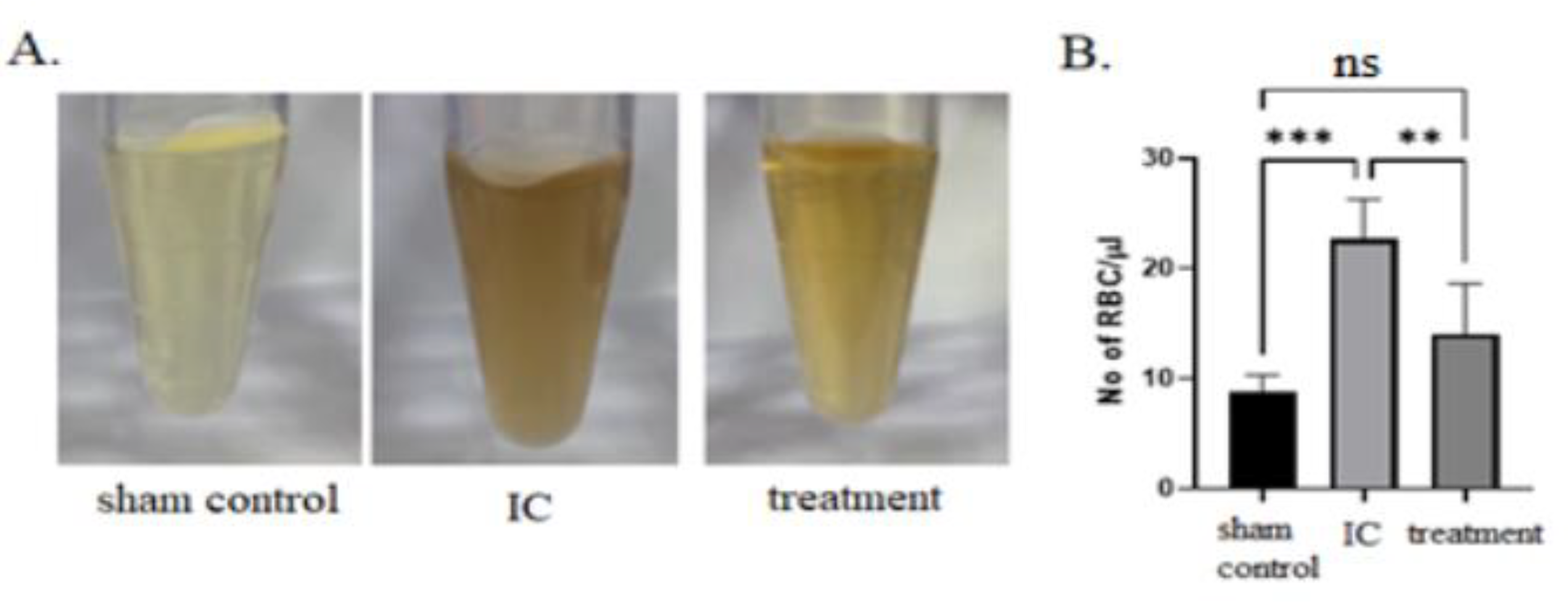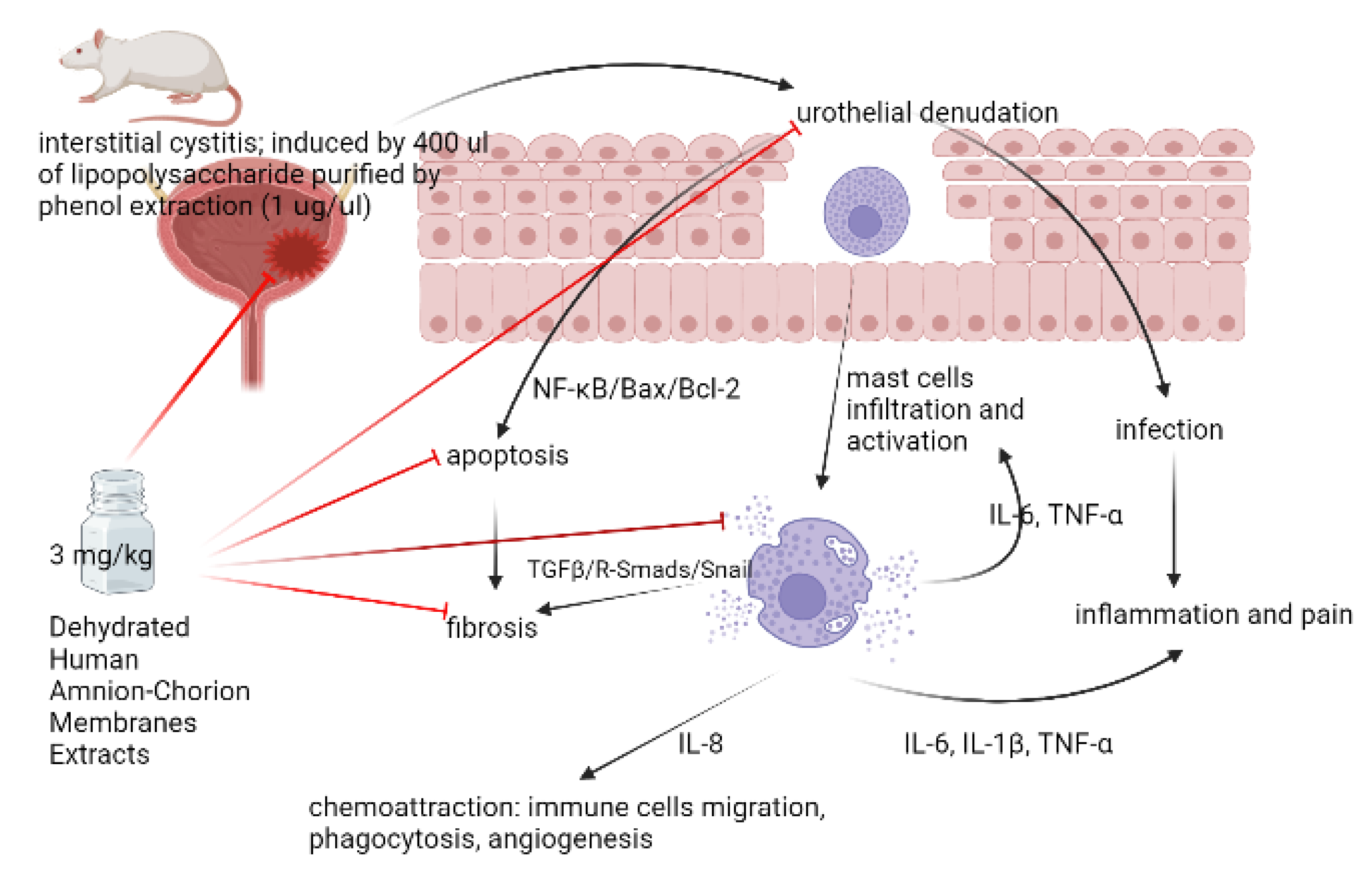Dehydrated Human Amnion-Chorion Membrane Extracts Can Ameliorate Interstitial Cystitis in Rats by Down-Regulating Inflammatory Cytokines and Protein Coding Genes: A Preclinical Study
Abstract
:1. Introduction
2. Materials and Methods
2.1. Animals
2.2. Rats Model Establishment
2.3. Induction of LPS-Induced Cystitis and Dehydrated HACM Extracts Administration
2.4. Histological Examinations
2.5. Estimation of Concentrations of Inflammatory Cytokines, NF-κB Activity and Oxidative Markers
2.6. Western Blotting
2.7. Statistical Analysis
3. Results
3.1. Dehydrated HACM Extracts Improved Hematuria and Histological Pathologies in Rats with LPS-Induced IC
3.2. Dehydrated HACM Extracts Decreased Inflammatory Cytokines and Fibrosis-Related Encoding Genes in UB Tissues of Rats with LPS-Induced IC
3.3. Dehydrated HACM Extracts Triggered Anti-Oxidative Effects in UB Tissues of Rats with LPS-Induced IC
3.4. Dehydrated HACM Extracts Might Enhance Anti-Apoptosis in Rats UB Tissues with LPS-Induced IC
4. Discussion
5. Conclusions
Supplementary Materials
Author Contributions
Funding
Institutional Review Board Statement
Informed Consent Statement
Data Availability Statement
Conflicts of Interest
References
- Hanno, P.; Dmochowski, R. Status of international consensus on interstitial cystitis/bladder pain syndrome/painful bladder syndrome: 2008 snapshot. Neurourol. Urodyn. 2009, 28, 274–286. [Google Scholar] [CrossRef] [PubMed]
- Hanno, P.M.; Burks, D.A.; Clemens, J.Q.; Dmochowski, R.R.; Erickson, D.; FitzGerald, M.P.; Forrest, J.B.; Gordon, B.; Gray, M.; Mayer, R.D.; et al. AUA guideline for the diagnosis and treatment of interstitial cystitis/bladder pain syndrome. J. Urol. 2011, 185, 2162–2170. [Google Scholar] [CrossRef] [PubMed]
- Hanno, P.M.; Erickson, D.; Moldwin, R.; Faraday, M.M. Diagnosis and Treatment of Interstitial Cystitis/Bladder Pain Syndrome: AUA Guideline Amendment. J. Urol. 2015, 193, 1545–1553. [Google Scholar] [CrossRef] [PubMed]
- van de Merwe, J.P.; Nordling, J.; Bouchelouche, P.; Bouchelouche, K.; Cervigni, M.; Daha, L.K.; Elneil, S.; Fall, M.; Hohlbrugger, G.; Irwin, P.; et al. Diagnostic criteria, classification, and nomenclature for painful bladder syndrome/interstitial cystitis: An ESSIC proposal. Eur Urol. 2008, 53, 60–67. [Google Scholar] [CrossRef] [PubMed]
- Konkle, K.S.; Berry, S.H.; Elliott, M.N.; Hilton, L.; Suttorp, M.J.; Clauw, D.J.; Clemens, J.Q. Comparison of an Interstitial Cystitis/Bladder Pain Syndrome Clinical Cohort with Symptomatic Community Women from the RAND Interstitial Cystitis Epidemiology Study. J. Urol. 2012, 187, 508–512. [Google Scholar] [CrossRef] [Green Version]
- Suskind, A.M.; Berry, S.H.; Ewing, B.A.; Elliott, M.N.; Suttorp, M.J.; Clemens, J.Q. The prevalence and overlap of interstitial cystitis/bladder pain syndrome and chronic prostatitis/chronic pelvic pain syndrome in men: Results of the RAND Interstitial Cystitis Epidemiology male study. J. Urol. 2013, 189, 141–145. [Google Scholar] [CrossRef] [Green Version]
- Homma, Y.; Akiyama, Y.; Tomoe, H.; Furuta, A.; Ueda, T.; Maeda, D.; Lin, A.T.; Kuo, H.-C.; Lee, M.-H.; Oh, S.-J.; et al. Clinical guidelines for interstitial cystitis/bladder pain syndrome. Int. J. Urol. 2020, 27, 578–589. [Google Scholar] [CrossRef]
- Leppilahti, M.; Tammela, T.L.; Huhtala, H.; Auvinen, A. Prevalence of symptoms related to interstitial cystitis in women: A population based study in Finland. J. Urol. 2002, 168, 139–143. [Google Scholar] [CrossRef]
- Lee, J.W.; Yoo, K.H.; Choi, H. Prevalence of Bladder Pain Syndrome-like Symptoms: A Population-based Study in Korea. J. Korean Med. Sci. 2021, 36, e293. [Google Scholar] [CrossRef]
- Jhang, J.F.; Hsu, Y.H.; Kuo, H.C. Urothelial functional protein and sensory receptors in patients with interstitial cystitis/bladder pain syndrome with and without Hunner’s lesion. Urology 2016, 98, 44–49. [Google Scholar] [CrossRef]
- Parsons, C.L. The Role of the Urinary Epithelium in the Pathogenesis of Interstitial Cystitis/Prostatitis/Urethritis. Urology 2007, 69, S9–S16. [Google Scholar] [CrossRef] [PubMed]
- Peeker, R.; Enerbäck, L.; Fall, M.; Aldenborg, F. Recruitment, distribution and phenotypes of mast cells in interstitial cystitis. J. Urol. 2000, 163, 1009–1015. [Google Scholar] [CrossRef]
- Theoharides, T.C.; Kempuraj, D.; Sant, G.R. Mast cell involvement in interstitial cystitis: A review of human and experimental evidence. Urology 2001, 57, 47–55. [Google Scholar] [CrossRef]
- Nazif, O.; Teichman, J.M.; Gebhart, G. Neural Upregulation in Interstitial Cystitis. Urology 2007, 69, S24–S33. [Google Scholar] [CrossRef] [PubMed]
- Giusto, L.L.; Zahner, P.M.; Shoskes, D.A. An evaluation of the pharmacotherapy for interstitial cystitis. Expert Opin. Pharmacother. 2018, 19, 1097–1108. [Google Scholar] [CrossRef] [PubMed]
- Pyo, J.-S.; Cho, W.J. Systematic Review and Meta-Analysis of Intravesical Hyaluronic Acid and Hyaluronic Acid/Chondroitin Sulfate Instillation for Interstitial Cystitis/Painful Bladder Syndrome. Cell. Physiol. Biochem. 2016, 39, 1618–1625. [Google Scholar] [CrossRef] [Green Version]
- Cervigni, M.; Sommariva, M.; Tenaglia, R.; Porru, D.; Ostardo, E.; Giammò, A.; Trevisan, S.; Frangione, V.; Ciani, O.; Tarricone, R.; et al. A randomized, open-label, multicenter study of the efficacy and safety of intravesical hyaluronic acid and chondroitin sulfate versus dimethyl sulfoxide in women with bladder pain syndrome/interstitial cystitis. Neurourol. Urodyn. 2016, 36, 1178–1186. [Google Scholar] [CrossRef] [Green Version]
- Han, S.; Dong, K.; Shen, M.; Wang, X.; Jiang, W.; Zhao, W.; Xu, D. Observation and mechanism study of bladder wound healing after transurethral holmium laser resection of bladder tumor. Lasers Med. Sci. 2019, 34, 1217–1227. [Google Scholar] [CrossRef]
- Tambaro, S.; Casu, M.A.; Mastinu, A.; Lazzari, P. Evaluation of selective cannabinoid CB1 and CB2 receptor agonists in a mouse model of lipopolysaccharide-induced interstitial cystitis. Eur. J. Pharmacol. 2014, 729, 67–74. [Google Scholar] [CrossRef]
- Song, P.H.; Chun, S.Y.; Chung, J.-W.; Kim, Y.Y.; Lee, H.J.; Lee, J.N.; Ha, Y.-S.; Yoo, E.S.; Kwon, T.G.; Kim, J.; et al. Comparison of 5 Different Rat Models to Establish a Standard Animal Model for Research into Interstitial Cystitis. Int. Neurourol. J. 2017, 21, 163–170. [Google Scholar] [CrossRef]
- Medina-Aguinaga, D.; Hoey, R.F.; Munoz, A.; Altamira-Camacho, M.; Quintanar, J.L.; Hubscher, C.H. Choice of cystometric technique impacts detrusor contractile dynamics in wistar rats. Physiol. Rep. 2021, 9, e14724. [Google Scholar] [CrossRef] [PubMed]
- Gomes, C.M.; Sánchez-Ortiz, R.F.; Harris, C.; Wein, A.J.; Rovner, E.S. Significance of hematuria in patients with interstitial cystitis: Review of radiographic and endoscopic findings. Urology 2001, 57, 262–265. [Google Scholar] [CrossRef]
- Wennevik, G.E.; Meijlink, J.M.; Hanno, P.M.; Nordling, J. The Role of Glomerulations in Bladder Pain Syndrome: A Review. J. Urol. 2015, 195, 19–25. [Google Scholar] [CrossRef] [PubMed]
- Shin, J.H.; Kang, B.; Choo, M.-S. Features of Various Bladder Lesions and Their Impact on Clinical Symptoms and Recurrence in Interstitial Cystitis. J. Urol. 2021, 206, 669–678. [Google Scholar] [CrossRef] [PubMed]
- Hu, Z.Q.; Kobayashi, K.; Zenda, N.; Shimamura, T. Tumor necrosis factor-α–and interleukin-6–triggered mast cell development from mouse spleen cells. Blood J. Am. Soc. Hematol. 1997, 89, 526–533. [Google Scholar] [CrossRef]
- Wang, X.; Liu, W.; O’Donnell, M.; Lutgendorf, S.; Bradley, C.; Schrepf, A.; Liu, L.; Kreder, K.; Luo, Y. Evidence for the Role of Mast Cells in Cystitis-Associated Lower Urinary Tract Dysfunction: A Multidisciplinary Approach to the Study of Chronic Pelvic Pain Research Network Animal Model Study. PLoS ONE 2016, 11, e0168772. [Google Scholar] [CrossRef] [Green Version]
- Akiyama, Y.; Maeda, D.; Morikawa, T.; Niimi, A.; Nomiya, A.; Yamada, Y.; Igawa, Y.; Goto, A.; Fukayama, M.; Homma, Y. Digital quantitative analysis of mast cell infiltration in interstitial cystitis. Neurourol. Urodyn. 2017, 37, 650–657. [Google Scholar] [CrossRef] [Green Version]
- Lu, K.; Wei, S.; Wang, Z.; Wu, K.; Jiang, J.; Yan, Z.; Cheng, Y. Identification of novel biomarkers in Hunner’s interstitial cystitis using the CIBERSORT, an algorithm based on machine learning. BMC Urol. 2021, 21, 109. [Google Scholar] [CrossRef]
- Cheng, X.-F.; Zeng, Z.-H.; Deng, W.; Liu, Y.-F.; Zhou, X.-C.; Zhang, C.; Wang, G.-X. Integrated Analysis of Microarray Studies to Identify Novel Diagnostic Markers in Bladder Pain Syndrome/Interstitial Cystitis with Hunner Lesion. Int. J. Gen. Med. 2022, 15, 3143–3154. [Google Scholar] [CrossRef]
- Gamper, M.; Regauer, S.; Welter, J.; Eberhard, J.; Viereck, V. Are mast cells still good biomarkers for bladder pain syndrome/interstitial cystitis? J. Urol. 2015, 193, 1994–2000. [Google Scholar] [CrossRef]
- Shenhar, C.; Kass, A.; Yakimov, M.; Golan, S.; Baniel, J.; Gilon, G.; Aharony, S. Bladder pain syndrome-does detrusor mastocytosis predict symptomatic improvement following bladder hydrodistention under anesthesia? Harefuah 2021, 160, 586–593. [Google Scholar] [PubMed]
- Abdel-Mageed, A.B.; Ghoniem, G.M. Potential role of rel/nuclear factor-kappaB in the pathogenesis of interstitial cystitis. J. Urol. 1998, 160, 2000–2003. [Google Scholar] [CrossRef]
- Abdel-Mageed, A.B.; Bajwa, A.; Shenassa, B.B.; Human, L.; Ghoniem, G.M. NF-kappaB-dependent gene expression of proinflammatory cytokines in T24 cells: Possible role in interstitial cystitis. Urol Res. 2003, 31, 300–305. [Google Scholar] [CrossRef] [PubMed]
- Barkett, M.; Gilmore, T.D. Control of apoptosis by Rel/NF-kappaB transcription factors. Oncogene 1999, 18, 6910–6924. [Google Scholar] [CrossRef] [PubMed] [Green Version]
- Redza-Dutordoir, M.; Averill-Bates, D.A. Activation of apoptosis signalling pathways by reactive oxygen species. Biochim. Biophys. Acta (BBA) Mol. Cell Res. 2016, 1863, 2977–2992. [Google Scholar] [CrossRef] [PubMed]
- Grover, S.; Srivastava, A.; Lee, R.; Tewari, A.K.; Te, A.E. Role of inflammation in bladder function and interstitial cystitis. Ther. Adv. Urol. 2011, 3, 19–33. [Google Scholar] [CrossRef] [PubMed]
- Peeker, R.; Aldenborg, F.; Fall, M. Complete Transurethral Resection of Ulcers in Classic Interstitial Cystitis. Int. Urogynecology J. 2000, 11, 290–295. [Google Scholar] [CrossRef]
- LLijnen, P.; Petrov, V.; Rumilla, K.; Fagard, R. Transforming growth factor-beta1 promotes contraction of collagen gel by cardiac fibroblasts through their differentiation into myofibroblasts. Methods Find. Exp. Clin. Pharmacol. 2003, 25, 79–86. [Google Scholar] [CrossRef]
- Akiyama, Y. Biomarkers in Interstitial Cystitis/Bladder Pain Syndrome with and without Hunner Lesion: A Review and Future Perspectives. Diagnostics 2021, 11, 2238. [Google Scholar] [CrossRef]
- Akiyama, Y.; Zaitsu, M.; Watanabe, D.; Yoshimura, I.; Niimi, A.; Nomiya, A.; Yamada, Y.; Sato, Y.; Nakamura, M.; Kawai, T.; et al. Relationship between the frequency of electrocautery of Hunner lesions and changes in bladder capacity in patients with Hunner type interstitial cystitis. Sci. Rep. 2021, 11, 105. [Google Scholar] [CrossRef]
- Trama, F.; Illiano, E.; Marchesi, A.; Brancorsini, S.; Crocetto, F.; Pandolfo, S.D.; Zucchi, A.; Costantini, E. Use of Intravesical Injections of Platelet-Rich Plasma for the Treatment of Bladder Pain Syndrome: A Comprehensive Literature Review. Antibiotics 2021, 10, 1194. [Google Scholar] [CrossRef] [PubMed]








Publisher’s Note: MDPI stays neutral with regard to jurisdictional claims in published maps and institutional affiliations. |
© 2022 by the authors. Licensee MDPI, Basel, Switzerland. This article is an open access article distributed under the terms and conditions of the Creative Commons Attribution (CC BY) license (https://creativecommons.org/licenses/by/4.0/).
Share and Cite
Yang, C.-H.; Tung, M.-C.; Lin, Y.-S.; Hsu, C.-Y.; Akhrymuk, I.; Tan, K.-T.; Ou, Y.-C.; Lin, C.-C. Dehydrated Human Amnion-Chorion Membrane Extracts Can Ameliorate Interstitial Cystitis in Rats by Down-Regulating Inflammatory Cytokines and Protein Coding Genes: A Preclinical Study. Life 2022, 12, 1693. https://doi.org/10.3390/life12111693
Yang C-H, Tung M-C, Lin Y-S, Hsu C-Y, Akhrymuk I, Tan K-T, Ou Y-C, Lin C-C. Dehydrated Human Amnion-Chorion Membrane Extracts Can Ameliorate Interstitial Cystitis in Rats by Down-Regulating Inflammatory Cytokines and Protein Coding Genes: A Preclinical Study. Life. 2022; 12(11):1693. https://doi.org/10.3390/life12111693
Chicago/Turabian StyleYang, Che-Hsueh, Min-Che Tung, Yi-Sheng Lin, Chao-Yu Hsu, Ivan Akhrymuk, Kok-Tong Tan, Yen-Chuan Ou, and Chi-Chien Lin. 2022. "Dehydrated Human Amnion-Chorion Membrane Extracts Can Ameliorate Interstitial Cystitis in Rats by Down-Regulating Inflammatory Cytokines and Protein Coding Genes: A Preclinical Study" Life 12, no. 11: 1693. https://doi.org/10.3390/life12111693





